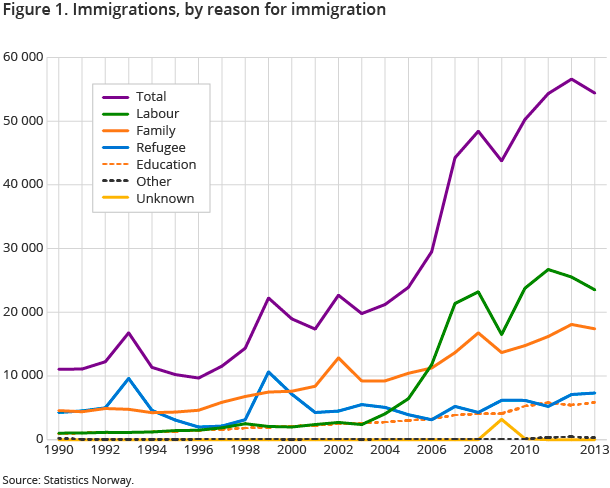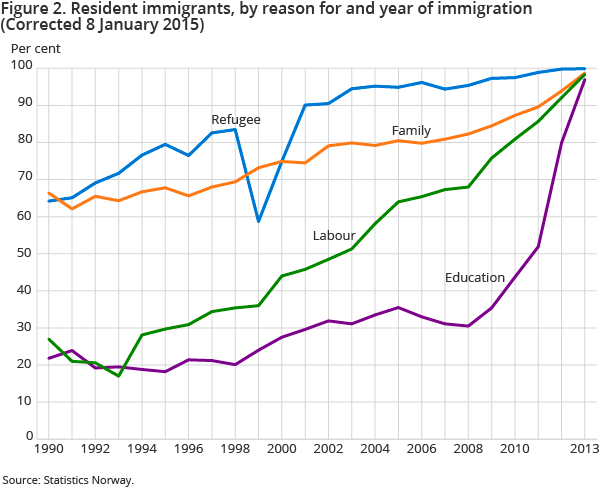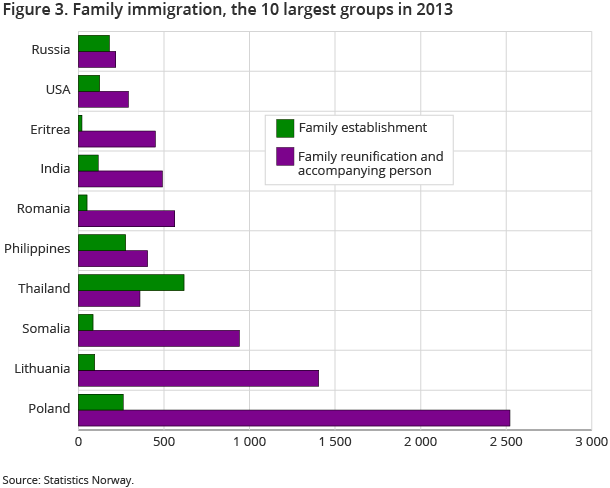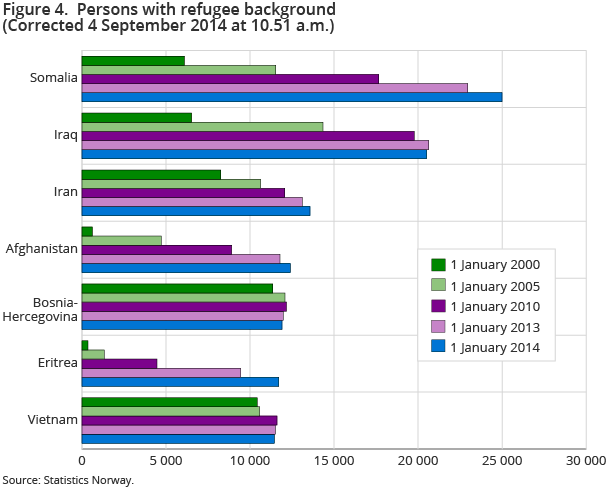Content
Published:
This is an archived release.
Labour immigration remains high despite fall
A total of 54 500 persons with non-Nordic citizenship immigrated to Norway in 2013. This is a decrease of 2 200 persons compared with the record year 2012. Labour immigration showed the highest decrease, but was nevertheless still high.
| 2013 | Change in per cent | Total immigration since 1990 | ||
|---|---|---|---|---|
| 2012 - 2013 | 2003 - 2013 | |||
| Total | 54 394 | -3.9 | 174.8 | 635 943 |
| Labour | 23 517 | -7.9 | 888.5 | 206 979 |
| Family | 17 400 | -3.8 | 88.8 | 231 769 |
| Refugee | 7 326 | 3.3 | 33.0 | 123 998 |
| Education | 5 852 | 7.85 | 124.6 | 66 646 |
| Other | 299 | -34.7 | 243.7 | 3 212 |





Labour was the reason for immigration for 43 per cent of immigrants in 2013, and one third came because of family. Thirteen and ten per cent came because of flight and studies respectively.
Reduced labour immigration
In 2013, labour immigration decreased by about 8 per cent from 2012 but was still one of the highest levels ever recorded. A total of 23 500 persons from non-Nordic countries immigrated due to labour in 2013. Seven out of ten of these came from the new EU countries. Labour immigrants from Poland made up the largest group in 2013, with 7 000 persons. Lithuanian labour immigrants followed next with 3 900 persons.
Fewer family immigrants
Family immigration in 2013 decreased by about 4 per cent compared with 2012. A total of 17 400 persons immigrated for family reasons. The two largest groups of family immigrants were Polish (2 800) and Lithuanians (1 500).
Family immigration includes persons who immigrate through family reunification and those who immigrate through family establishment. Out of the 17 400 persons who came to Norway due to family reasons, 13 200 came as family reunified and 4 200 immigrated for family establishment (through marriage). Out of those who came to Norway due to marriage, 54 per cent had a spouse with an immigrant background.
Small increase in number of refugees
Compared with 2012, 200 more persons came to Norway due to flight, with a total of 7 300. Despite the increase, this group made up only 13 per cent of the non-Nordic immigrants in 2013. Most of this group were from Eritrea (2 100) and Somalia (1 500). The number of refugees from Syria saw a significant increase, from 300 persons in 2012 to 700 persons in 2013.
One third with education permit came from Philippines
A total of 5 900 persons immigrated in 2013 due to education or cultural exchange. This was a slight increased compared with the previous year. There were many immigrants from the Philippines in this group; 1 900 persons, or 33 per cent. The number of registered persons for the Philippines is so high because the au pair permit is also considered to be a type of education permit.
High portion of residents
Not everyone who immigrates to Norway stays here for the rest of their life. A total of 636 000 persons with non-Nordic citizenship immigrated to Norway between 1990 and 2013, and 75 per cent of these were still living here at the beginning of 2014.
The reason for immigration has a bearing on the degree to which they leave the country. Of those who immigrated due to flight, 85 per cent were still living in the country on 1 January 2014. The corresponding percentage for those who immigrated for education was just 42 per cent.
179 500 with refugee background
A total of 179 500 persons with a refugee background were living in Norway on 1 January 2014. This made up 3.5 per cent of the total population and 28.4 per cent of immigrants in Norway. In 2013, the number of persons with a refugee background increased by 7 900 persons. The largest increase was among persons from Eritrea, Somalia and Syria, with 2 300, 2 000 and 1 000 respectively.
Somalis are the largest group, with a total of 25 000 persons, followed by persons with a refugee background from Iraq and Iran, with 20 500 and 13 600 respectively.
Persons with refugee background in almost all municipalities
There were persons with a refugee background in 409 of the 428 municipalities. In 32 of these municipalities, more than 1 000 persons had a refugee background. Oslo had the most residents with a refugee background, with 44 600, followed by Bergen (9 600) and Trondheim (6 000).
More about 'immigrants by reason for immigration'Open and readClose
The statistics on reason for immigration give a breakdown of all persons who have immigrated to Norway for the first time, and were registered as a resident in the year, by reason for immigration. The person no longer has to be a resident. The breakdown is based on first citizenship. A person cannot be included in the statistics for two different years. The statistics include the years 1990-2013. More information can be found in About the statistics.
More about 'persons with a refugee background' Open and readClose
The statistics on persons with a refugee background include all persons with a refugee background who were residents on 1 January in the current year. The term 'persons with refugee background' includes all persons whose reason for immigration status is 'refugee' and all persons with 'family' status who have been reunited with a family member. The breakdown is based on country of birth. A person with a refugee background will be included in the statistics every year that they are a resident. The statistics have been published since 1998. More information can be found in About the statistics .
Contact
-
Statistics Norway's Information Centre
E-mail: informasjon@ssb.no
tel.: (+47) 21 09 46 42
-
Oppdrag innvandring
E-mail: oppdraginnvandring@ssb.no
-
Mads Ivar Kirkeberg
E-mail: mads.ivar.kirkeberg@ssb.no
tel.: (+47) 40 81 13 21
-
Frøydis Strøm
E-mail: froydis.strom@ssb.no
tel.: (+47) 40 81 13 17
